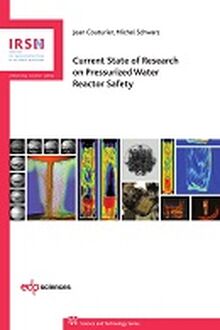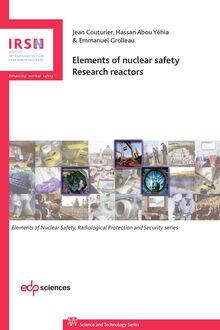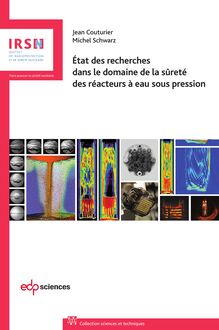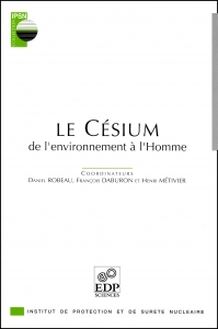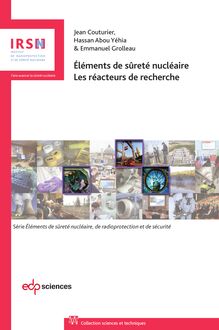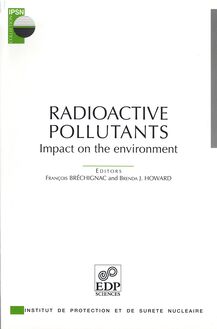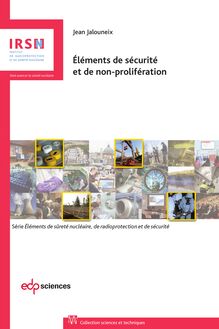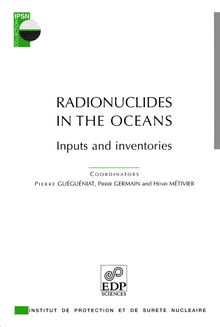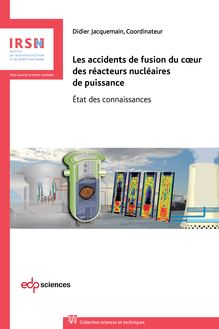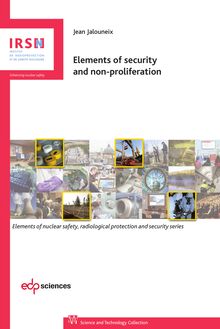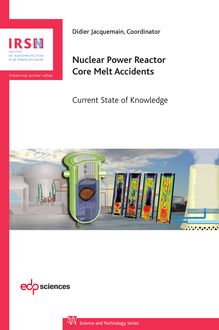Current state of research on pressurized water reactor safety , livre ebook
228
pages
English
Ebooks
2018
Obtenez un accès à la bibliothèque pour le consulter en ligne En savoir plus
Découvre YouScribe en t'inscrivant gratuitement
Découvre YouScribe en t'inscrivant gratuitement
228
pages
English
Ebooks
2018
Obtenez un accès à la bibliothèque pour le consulter en ligne En savoir plus
Publié par
Date de parution
06 mars 2018
Nombre de lectures
0
EAN13
9782759821655
Langue
English
Poids de l'ouvrage
5 Mo
For more than 40 years, IPSN then IRSN has conducted research and development on nuclear safety, specifically concerning pressurized water reactors, which are the reactor type used in France. This publication reports on the progress of this research and development in each area of study – loss-of-coolant accidents, core melt accidents, fires and external hazards, component aging, etc. –, the remaining uncertainties and, in some cases, new measures that should be developed to consolidate the safety of today’s reactors and also those of tomorrow. A chapter of this report is also devoted to research into human and organizational factors, and the human and social sciences more generally. All of the work is reviewed in the light of the safety issues raised by feedback from major accidents such as Chernobyl and Fukushima Daiichi, as well as the issues raised by assessments conducted, for example, as part of the ten-year reviews of safety at French nuclear reactors. Finally, through the subjects it discusses, this report illustrates the many partnerships and exchanges forged by IRSN with public, industrial and academic bodies both within Europe and internationally.
This publication reflects IRSN’s desire to keep an enduring record of its results and to share its knowledge.
Publié par
Date de parution
06 mars 2018
Nombre de lectures
0
EAN13
9782759821655
Langue
English
Poids de l'ouvrage
5 Mo
Science and Technology Series
Jean Couturier, Michel Schwarz
Current State of Research
on Pressurized Water Reactor Safety
Current State of Research
Jean Couturier, Michel Schwarz
on Pressurized Water For more than 40 years, IPSN then IRSN has conducted research and development Enhancing nuclear safety
on nuclear safety, specifically concerning pressurized water reactors, which are Reactor Safetythe reactor type used in France. This publication reports on the progress of this
research and development in each area of study – loss-of-coolant accidents, core
melt accidents, fires and external hazards, component aging, etc. –, the remaining
uncertainties and, in some cases, new measures that should be developed to
consolidate the safety of today’s reactors and also those of tomorrow. A chapter
of this report is also devoted to research into human and organizational factors,
and the human and social sciences more generally. All of the work is reviewed
in the light of the safety issues raised by feedback from major accidents such as
Chernobyl and Fukushima Daiichi, as well as the issues raised by assessments
conducted, for example, as part of the ten-year reviews of safety at French nuclear
reactors. Finally, through the subjects it discusses, this report illustrates the many
partnerships and exchanges forged by IRSN with public, industrial and academic
bodies both within Europe and internationally.
This publication reflects IRSN’s desire to keep an enduring record of its results and
to share its knowledge.
IRSN is a public industrial and commercial body undertaking research and consultancy
in the field of nuclear safety and radiation protection. It provides the public authorities
with technical support. It also carries out various public service missions entrusted to
it under national regulations. In particular, these include radiological monitoring of
the environment and workers in France, managing emergency situations, and keeping
the public informed. IRSN makes its expertise available to partners and customers
both in France and worldwide.
ISBN : 978-2-7598-2164-8
Head offi ce
31, avenue de la Division Leclerc
92260 Fontenay-aux-Roses
RCS Nanterre B 440 546 018
Telephone +33 (0)1 58 35 88 88
Postal Address 9782759 821648
B.P. 17 - 92262 Fontenay-aux-Roses Cedex
France Price : 35 euros
Website www.irsn.fr
Science and Technology Series
Science and Technology Series
Current State of Research on Pressurized Water Reactor SafetyAnglais_Book 12/14/2017 11:26:36 Page 1
CurrentStateofResearch
onPressurizedWaterReactorSafety
JeanCouturier, MichelSchwarzAnglais_Book 12/14/2017 11:26:38 Page 2
Cover illustrations: photographs showing research and development in pressurized water
reactorsafetyatIRSN.Fromlefttoright:thehydrogenriskinnuclearreactors©IRSNInstitut
Icare; image from a 3D simulation by the MC3D code of corium dispersion in the water in a
reactorpitintheeventofacentralreactorvesselfailure©IRSN;statesofdegradationoffuel
assembliesfromthePhébus-PFprogram©IRSN;aprototypeoftheconformabletransducer–
IRSN/CEApatent©IRSN/CEA(bottom);Phébus-LOCA–sectionview(post-mortem)ofatest
fuelclusterfollowingatemperature transienttypicalofaLOCA ©IRSN(top);anexperiment
involving a fire in a stack of cable raceways © Florent–Frédéric Vigroux/IRSN (bottom); 2D
model of the Nice basin; below, amplification of seismic waves calculated by a numerical
simulation of seismic wave propagation in this model © Fabien Peyrusse/Inria; fire test on
electrical cables © Florent–Frédéric Vigroux/IRSN (bottom).
Printed in France
ISBN (print): 978-2-7598-2164-8 – ISBN (ebook): 978-2-7598-2165-5
DOI: 10.1051/978-2-7598-2164-8
All rights relative to translation, adaptation and reproduction by any means whatsoever are
reserved, worldwide. In accordance with the terms of paragraphs 2 and 3 of Article 41 of the
FrenchActdatedMarch11,1957,“copiesorreproductionsreservedstrictlyforprivateuseand
not intended for collective use” and, on the other hand, analyses and short quotations for
exampleorillustrativepurposes,areallowed.Otherwise, “anyrepresentationorreproduction
-whetherinfullorinpart–withouttheconsentoftheauthororofhissuccessorsorassigns,is
unlawful” (Article 40, paragraph 1). Any representation or reproduction, by any means
whatsoever, willthereforebedeemedaninfringementofcopyrightpunishableunderArticles
425 and following of the French Penal Code.
IRSN 2018Anglais_Book 12/14/2017 11:26:38 Page 3
Preface
This publication sets out to provide an overview of much of the research and
development work carried out over the past forty years in thefield of pressurized water
reactor safety, in particular by the Institut de Protection et de Sûreté Nucléaire (IPSN),
later becoming the Institut de Radioprotection et de Sûreté Nucléaire (IRSN), whether
aloneorincollaborationwithotherorganizations.Thiswork–andthelessonsthatcanbe
learned from it – is set in front of the safety issues raised during assessments of French
nuclear power plants, or following incidents and accidents that have occurred, such as
thoseaffectingreactor2attheThreeMileIslandnuclearpowerplantin1979,reactor4at
theChernobylnuclearpowerplantin1986and, morerecently,attheFukushima Daiichi
nuclear power plant in 2011.
The safety of nuclear facilities is part of a continuous improvement process that is
based on:
– national and international operating experience feedback,
– andknowledgeacquiredthroughresearchanddevelopment,withassessmentand
research activities fueling each other.
Since the 1980s, safety reviews have been carried out at nuclear power plants
operatedbyÉlectricitédeFrance(EDF),thenationalpowerutility,aspartofaten-yearly
outage program. These provide an opportunity to ensure that lessons learned from
operating experience feedback and R&D work flow down to the operational level.
Theresearchanddevelopmentthemesrelatingtopressurizedwaterreactorsafetyin
whichIRSNhasbeen –andforthemostpartstillis –particularlyinvolvedarepartofthe
generalinitiativetoprevent andmitigatetheimpactofpostulatedevents.Theseinclude
internalevents,suchasthelossofcoolantoranuncontrolledincreaseofreactivityinthe
core until it melts, and "hazards" such as earthquakes, externalflooding, andfires inside
or outside facilities. The knowledge acquired through research on core melt accidents isAnglais_Book 12/14/2017 11:26:39 Page 4
IV Currentstate ofresearchonpressurizedwaterreactor safety
fedintoASTEC,anIRSNcomputercodeusedforsimulationpurposes,andinternationally
recognized as a reference tool.
Theauthorsalsowishedtoprovideapanoramaofstudiesandresearchworkrelating
to human and organizational factors, a theme that has been of concern to the
international community since the accidents at Three Mile Island and Chernobyl. The
safety issues raised by the growing tendency of licensees to work with subcontractors
have become major themes of studies and research today. Furthermore, since the
accident at the Fukushima Daiichi nuclear power plant, and the conclusions drawn from
theevent –inparticularthoseoftheNationalDietofJapanFukushimaNuclearAccident
Independent Investigation Commission, according to which various social factors
contributed to the accident – studies and research initiatives have covered topics in the
human and social sciences.
For each of the research and development themes addressed, the remaining
uncertainties and the new knowledge required are highlighted. Research in new areas,
such as topics relating to new reactor designs (passive safety, the possibility of retaining
the corium in the reactor vessel in the event of a core melt accident, etc.) is also
discussed.
The research and development work discussed in this publication illustrates IRSN’s
policy of openingup to the international community and the many ties ithasdeveloped
withit.Examplesincludedirecttieswithsimilarorganizations (suchastheUnitedStates
NRC or GRS in Germany) research operators (in particular the Commissariat à l’énergie
atomique et aux énergies alternatives [CEA] and universities) as well as involvement in
knowledge sharing organizations (such as the OECD Nuclear Energy Agency) and the
manyprojectsfundedinFrancebytheAgencenationaledelarecherche(ANR)andatthe
europeanlevelbytheEuropeanCommissionthroughitsmulti-yearFrameworkPrograms
(FP) for research and development. In addition, IRSN is closely involved in defining
European research strategies within the European Sustainable Nuclear Energy
Technology Platform (SNETP) and, since 2012, as a member of the NUGENIA association.
Iwouldespeciallyliketothankthetwomaincontributors,JeanCouturierandMichel
Schwarz, for this impressive summary (representing more than three years’ work) and,
more generally, all the IRSN experts for their invaluable assistance in this work.
Jean-Christophe Niel
IRSN Director-GeneralAnglais_Book 12/14/2017 11:26:39 Page 5
Theauthors
JeanCouturierworksattheofficeofIRSN’sDirectorGeneral,supportingtheroll-out
of a knowledge management program. He is also a senior expert (safety policies, risk
analyses).Hebeganhiscareerworkingonthedesignoffastreactors.From1982,hiswork
focused on nuclear safety not only for this type of reactor (PHENIX, SUPERPHENIX) but
alsoforresearchreactors,pressurizedwaterreactors,etc.HeisamemberoftheStanding
Group ofexpertsforReactorsandtheStandingGroupofexpertsonNuclearPressurized
Equipment.
Michel Schwarz retired from IRSN in 2012. He spent his career in nuclear safety
research.Inparticular,heranthePhébus-PFinternationalresearchprogramoncoremelt
accidents in light water reactors. He was director of major accident prevention and then
IRSN’s scientific director. He is a member of ASN’s Scientific Committee.Anglais_Book 12/14/2017 11:26:39 Page 6Anglais_Book 12/14/2017 11:26:39 Page 7
Listofabbreviations
Glossaryofinstitutions
AEC: Atomic Energy Commission, USA (forerunner of the U.S.NRC)
AECL: Atomic Energy of Canada Limited, a nuclear science and technology research
institute
AFPS: Association française du génie parasismique (French Earthquake Enginee
